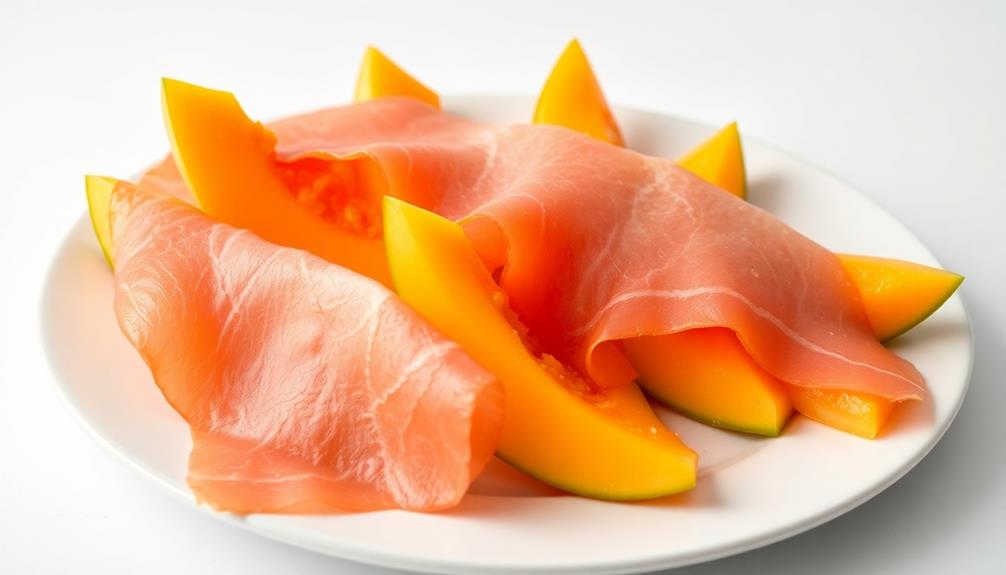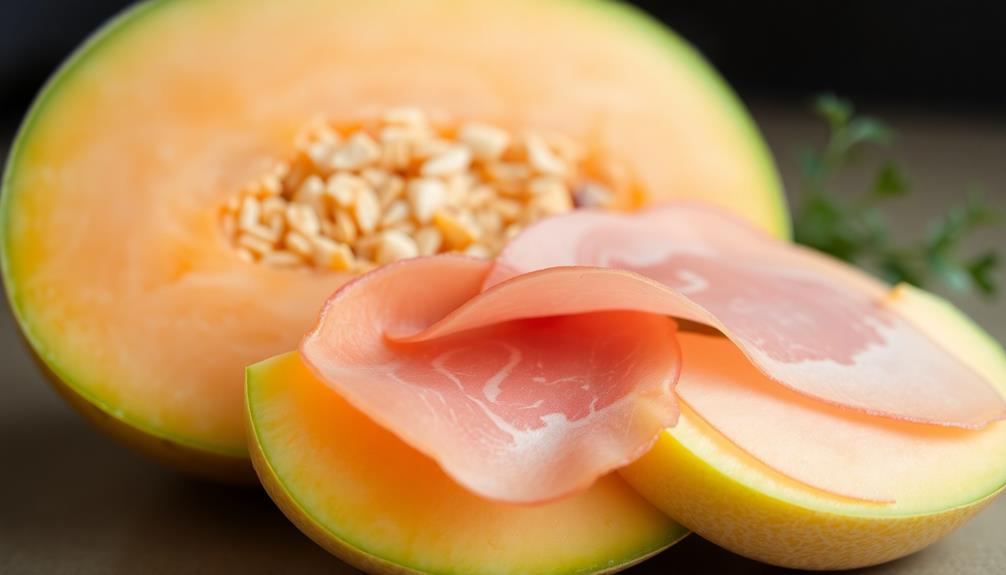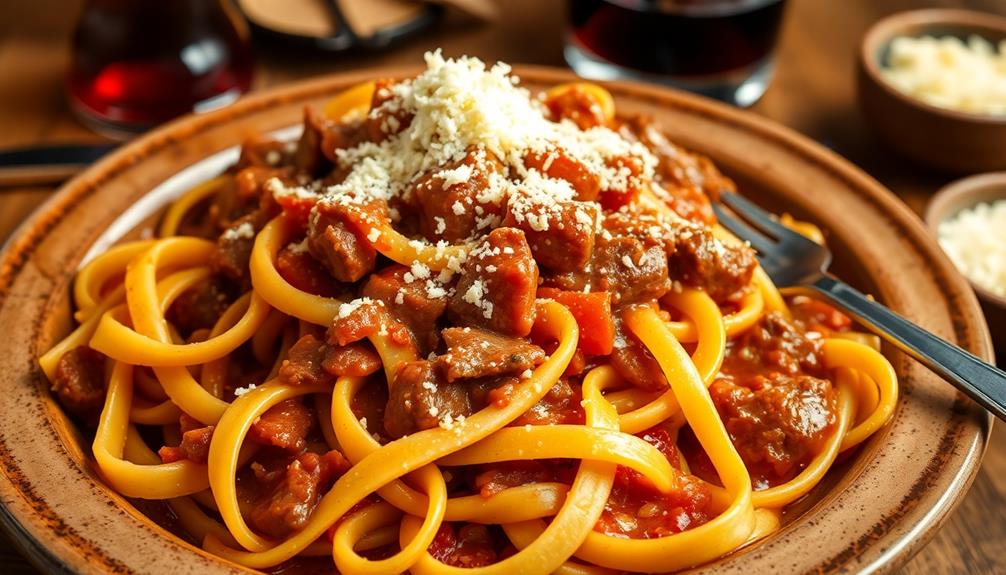Prosciutto and melon – a classic Italian summer combo that'll transport you right to the Mediterranean! You'll love how the salty, savory prosciutto perfectly complements the sweet, refreshing melon. It's a breeze to make, too – just wrap the prosciutto around juicy melon wedges, drizzle with balsamic, and garnish with fresh basil. This light and flavorful dish is perfect for outdoor gatherings or as a starter before a big meal. The balance of textures and tastes is simply divine. Get ready to fall in love with this timeless Italian delight!
Key Takeaways
- Prosciutto and melon is a classic Italian pairing featuring the contrast of salty cured ham and sweet, refreshing melon.
- The dish originates from the warm Mediterranean climate of Italy, where both prosciutto and melons have been staples for generations.
- The recipe showcases a balance of sweet and savory flavors, making it an ideal light starter or summer meal.
- High-quality ingredients, such as ripe melon and thinly sliced prosciutto, are essential for the best flavor experience.
- The dish is often enhanced with balsamic reduction and fresh basil, and pairs well with chilled white wine or sparkling beverages.
History
Prosciutto and melon, a classic pairing, has long been a summertime delight. This refreshing combination has its roots in Italian cuisine, where the salty, savory prosciutto and the sweet, juicy melon have come together for centuries.
The origins of this iconic dish can be traced back to the warm, Mediterranean climate of Italy, where the two key ingredients thrive. Prosciutto, the dry-cured ham, has been a staple in Italian kitchens for generations, while melons have been cultivated in the region for just as long.
As the flavors of these two foods intertwine, they create a perfect balance of salty and sweet, making it a beloved summertime treat.
Today, prosciutto and melon remains a popular appetizer or light meal, enjoyed by families and friends alike during the hot summer months. Its simplicity and refreshing nature make it a timeless classic that continues to delight taste buds around the world.
Recipe
Prosciutto and Melon is a classic Italian appetizer that showcases the perfect balance of salty and sweet flavors. The combination of the savory prosciutto and the refreshing, juicy melon creates a delightful and sophisticated dish that's perfect for summer gatherings or as a light starter.
This dish can be enjoyed alongside other seasonal treats, much like the thrilling attractions found at Ohio's Top Water Park Destinations that cater to all ages.
The key to making this dish successfully is to use high-quality ingredients. Opt for a ripe, in-season melon and thinly sliced prosciutto for the best texture and flavor profiles.
Ingredients:
- 1 ripe cantaloupe or honeydew melon, halved and seeded
- 8-10 slices of prosciutto
- Fresh basil leaves (optional)
Instructions:
Slice the melon halves into wedges or bite-sized pieces. Arrange the melon slices on a serving platter. Drape the prosciutto slices over the melon, allowing them to hang off the edges slightly. If desired, garnish with fresh basil leaves.
When serving, the contrast between the sweet, juicy melon and the salty, savory prosciutto is meant to be the star of the dish.
Consider pairing it with a crisp white wine or a sparkling beverage to enhance the flavors. Enjoy this simple yet elegant appetizer with friends and family.
Cooking Steps
Slice the juicy melon into thin, tempting wedges.
Carefully wrap the savory prosciutto around each piece, creating a mouthwatering combination.
Arrange the wrapped melon on a serving platter, then drizzle with a tangy balsamic reduction and sprinkle with fresh, fragrant basil leaves.
Step 1. Slice Melon Into Thin Wedges

To begin, select a ripe and juicy melon. Using a sharp knife, carefully slice the melon in half from top to bottom. Scoop out the seeds and discard them.
Place the melon halves cut-side down on a clean cutting board. Slice the melon into thin, uniform wedges about 1/2 inch thick. This will ensure even cooking and a lovely presentation.
Next, arrange the melon wedges on a serving platter. You can overlap the slices slightly for a visually appealing display. Drizzle the melon with a bit of high-quality olive oil, if desired, to enhance the natural sweetness.
The melon's cool, refreshing flavor pairs beautifully with the salty, savory prosciutto.
Serve the prosciutto and melon wedges immediately, allowing your guests to enjoy the delightful contrast of textures and flavors. This simple yet sophisticated appetizer is sure to delight everyone at your table.
Step 2. Wrap Prosciutto Around Melon Wedges

Take a slice of prosciutto and, with a gentle touch, wrap it around one of the melon wedges. The salty, savory flavor of the prosciutto perfectly complements the sweet, juicy melon.
Repeat this process, wrapping each melon wedge with a slice of prosciutto.
Arrange the wrapped melon wedges on a serving platter. The vibrant colors and elegant presentation make this dish a showstopper. Guests will be delighted by the burst of flavors in every bite.
For a finishing touch, drizzle a bit of aged balsamic vinegar over the wrapped melon. The tangy sweetness elevates the dish and brings all the flavors together harmoniously.
Prosciutto and melon is a classic pairing that's easy to prepare but looks and tastes impressive. Serve it as an appetizer or light summer meal, and enjoy the perfect balance of salty, sweet, and refreshing flavors.
Step 3. Arrange on Serving Platter

Arrange the wrapped melon wedges on a serving platter. Place them in a visually appealing pattern, with the melon's vibrant green hue peeking through the delicate pink prosciutto.
This delightful appetizer can be enhanced with a touch of spice by serving it alongside a small dish of samosas, adding an exciting contrast to the sweet and savory flavors. Scatter a few sprigs of fresh mint around the platter, adding a touch of freshness and color.
This appetizer is a true delight for the senses! The contrast between the sweet, juicy melon and the salty, savory prosciutto is simply divine.
As your guests arrive, they'll be drawn to the inviting display, eager to indulge in this classic Italian pairing. Encourage your loved ones to pick up the wedges and enjoy the burst of flavors.
The combination of the cool melon and the cured meat is sure to leave everyone craving more. Serve this delightful dish alongside chilled white wine or sparkling water for a refreshing and memorable start to your gathering.
Step 4. Drizzle With Balsamic Reduction

A balsamic reduction adds a delightful touch to this prosciutto and melon dish. Drizzle the reduction over the platter, allowing it to cascade down the sweet melon and salty prosciutto. The rich, syrupy glaze complements the flavors beautifully, creating a mouthwatering contrast.
To make the reduction, simmer balsamic vinegar in a small saucepan until it thickens to a syrup-like consistency. This should take about 10-15 minutes. Be sure to stir occasionally to prevent burning.
Once the reduction has reached the desired consistency, remove it from heat and let it cool slightly.
Then, use a spoon to drizzle the balsamic reduction over the arranged prosciutto and melon. Encourage guests to enjoy the interplay of sweet, salty, and tangy flavors in each bite. The balsamic reduction adds a touch of elegance and sophistication to this simple, yet delicious, appetizer.
Step 5. Sprinkle With Fresh Basil Leaves

Finally, sprinkle some freshly torn basil leaves over the platter. The vibrant green hues of the basil will add a beautiful pop of color, complementing the rich prosciutto and sweet melon. The fragrant aroma of the basil will tantalize your senses, heightening the overall sensory experience.
Tear the basil leaves into bite-sized pieces using your hands, distributing them evenly across the dish. The gentle tearing motion will help release the natural oils, intensifying the aromatic flavors. Feel free to use a generous amount – the basil will provide a lovely, fresh contrast to the salty prosciutto and juicy melon.
Once the basil is added, your prosciutto and melon platter is ready to serve. The combination of salty, sweet, and herbaceous flavors is sure to delight your taste buds.
Enjoy this refreshing and visually appealing appetizer with family and friends, celebrating the joys of summer.
Final Thoughts
Prosciutto and melon is a classic summer pairing that never fails to delight the senses. The salty, savory prosciutto perfectly complements the sweet, juicy melon, creating a burst of flavors that dance on your tongue.
It's a dish that's easy to prepare, yet so impressive – perfect for entertaining guests or enjoying as a light, refreshing snack on a warm summer day.
Don't be afraid to get creative with your presentation, either. Arrange the prosciutto-wrapped melon slices in an appealing pattern on a platter, and don't forget to sprinkle on the fresh basil leaves for a pop of color and flavor.
This dish is truly a summer celebration, capturing the essence of the season in every bite.
Frequently Asked Questions
Is Prosciutto E Melone a Traditional Italian Dish?
Yes, prosciutto e melone is a traditional Italian dish. It's a classic combination of salty prosciutto ham and sweet, juicy melon that's been enjoyed in Italy for centuries as a refreshing summer appetizer.
What Is the Best Type of Melon to Use?
The best type of melon to use is one that's ripe, juicy, and flavorful. Cantaloupe or honeydew are classic choices, but you can also experiment with other varieties like watermelon or casaba for a unique twist.
Can I Substitute the Prosciutto With Another Type of Cured Meat?
You can substitute the prosciutto with another type of cured meat, such as Serrano ham, Ibérico ham, or even smoked salmon. The key is to choose a salty, flavorful cured meat that complements the sweetness of the melon. For a healthier option, you could also consider using lean turkey or chicken breast. Another option is to add some fresh herbs such as basil or mint to enhance the flavors of the dish. Additionally, incorporating these natural supplement benefits can add extra nutritional value to the overall dish, making it a well-rounded and satisfying appetizer or light meal.
How Long Should the Prosciutto Be Aged?
The ideal aging time for prosciutto can vary, but generally, it should be aged for at least 12-24 months to develop the desired flavor and texture. You'll want to ensure the prosciutto has a firm, dry texture when it's ready to serve.
Is Prosciutto E Melone a Suitable Appetizer for Vegetarians?
No, prosciutto e melone would not be a suitable appetizer for vegetarians. Prosciutto is a cured, dry-aged ham made from pork, which makes it unsuitable for those following a vegetarian diet. You'll need to find a vegetarian-friendly alternative.










